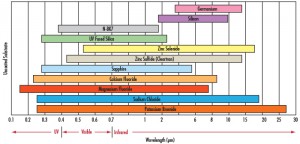When choosing the correct IR material, there are three simple points to consider. Though the selection process is easier because there is a much smaller practical selection of materials for use in the infrared compared to the visible, these materials also tend to be more expensive due to fabrication and material costs.
- Thermal Properties – Frequently, optical materials are placed in environments where they are subjected to varying temperatures. Additionally, a common concern with IR applications is their tendency to produce a large amount of heat. A material’s index gradient and coefficient of thermal expansion (CTE) should be evaluated to ensure the user is met with the desired performance. CTE is the rate at which a material expands or contracts given a change in temperature. For example, germanium has a very high index gradient, possibly degrading optical performance if used in a thermally volatile setting.
- Transmission – Different applications operate within different regions of the IR spectrum. Certain IR substrates perform better depending on the wavelength at hand. For example, if the system is meant to operate in the MWIR, germanium is a better choice than sapphire, which works well in the NIR.
- Index of Refraction – IR materials vary in terms of index of refraction far more than visible materials do, allowing for more variation in system design. Unlike visible materials (such as N-BK7) that work well throughout the entire visible spectrum, IR materials are often limited to a small band within the IR spectrum, especially when anti-reflection coatings are applied.
This article comes from edmundoptics edit released
